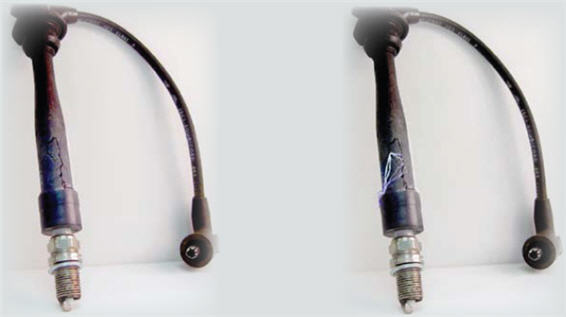With up to 40 kV of high tension voltage available from the ignition coil to the Spark Plug, high quality High tension (HT) Ignition Leads are essential. The most critical performance requirements that HT leads must meet are, high grade insulating properties, appropriate resistance and impedance, high temperature resistance and resistance against vibration.
There are three main types of ignition leads as follows:
1) Standard carbon core ignition leads. These are cheap and are used as OEM on most vehicles and have high resistance. In these leads the spark has to pass from particle to particle of the carbon core to reach the spark plug. This high resistance tends to shorten the spark duration available to ignite the mixture. The reason this type of lead is used in standard engines is because they offer good electrical noise suppression, thus allowing the use of cheaper radios, engine management systems etc. Standard engines also do not have the higher cylinder pressures that high performance engines have and as such, the mixtures are easier to ignite. These leads are not suitable for high output ignitions because the carbon core will burn out easily and are often of inferior quality as they are a cheap, mass produced item but in saying that there are many manufacturers that used high quality carbon core leads. There are many aftermarket HT lead manufacturers that produce leads in various sizes from 7mm to 10mm. Not all are what they claim to be. There are some cheap and nasty performance leads out there also.
Typical resistance of a carbon core lead is 2 to 10K ohms per foot of lead. Max 10K per lead.
Personally I would not exceed 8K ohms / ft
2) Pure wire core ignition leads. This type of lead is the opposite extreme to the carbon core ignition lead. They offer no resistance through a stainless or copper wire core. They were originally used in older vehicles pre 1960 or so, that used low output contact breaker ignition systems. These were used to try and maximise the spark available to the plug., but problems with cross firing and later when radios became more common, these leads caused interference with radio and also TV and other electronic equipment. For this reason they were not used on High Energy electronic Ignition systems as they damaged the system and voided all warranty's.
Wire leads have almost no resistance and should read near 0 ohms.
3) Induction wound / spiral wire core ignition leads. These are the most effective type of lead in every respect, offering relatively low resistance allowing the longest duration spark possible, while still having high levels of suppression, thus avoiding problems such as cross firing and electrical interference. They are ideal for all applications, but are especially useful in high performance engines, engines using exotic fuels or nitrous and those using LPG.
High quality HT leads are usually found in performance shops and good auto spare shops and are generally not available separately. They are packaged in sets and each set is tailored to the right lead length and available in 5, 7, 8 & 10 mm thicknesses to suit the exact make and model of engine. Some sets, the leads are even numbered, which removes any confusion during installation. These leads of course are the most expensive money can buy.
These HT leads would be the preferred lead for modern engines from the 90's on.
Typical resistance of a spiral would lead is 150 to 1.5K ohms / ft
In summary:
Older vehicle with points ignition were fitted with:
-
copper core or
-
carbon suppression leads.
Electronic ignition systems were fitted with:
-
Carbon core or
-
Spiral core
Distributorless ignition systems were fitted with:
- Spiral core
Spark Plug HT Lead Set Installation Instructions
Lay out the replacement leads arranging them in order of length. If you are not familiar with the direction of rotation in the distributor or which terminal is No.1 on the cap then only disconnect one cable at a time. This will prevent fitting the leads incorrectly on the distributor cap. Remove the longest spark plug lead from the engine first by grasping the boot (never the cable), and twisting slightly to break the seal between the boot and the spark plug. Now pull the boot straight off the spark plug to remove. The best way to remove HT leads is with a special set of pliers as shown below. The third photo shows not where to place the pliers. The same goes with your fingers, you must grip down on the boot, not up high as shown in the forth photo.
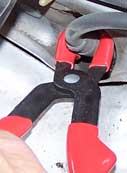


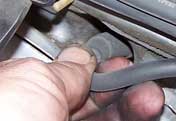
Observe the routing of the lead as many leads pass through looms or separators that must be disassembled in order to remove the lead. Remove the distributor end of the lead in the same manner as described above. Pay attention to the inside of the distributor cap tower for corrosion. If any is present, it must be cleaned before installing the new lead. Select the longest lead from the new set and apply a small amount of dielectric grease to the boots. This is used to seal the boots from dirt and moisture and also helps prevent the boots from sticking to the spark plug or cap/coil tower. Press the distributor cap terminal into the tower as far as it will go down. Next, slide the boot down tightly to seal out moisture. Carefully re-route the lead through any looms or separators. Install the terminal onto the spark plug. Push hard until the terminal “snaps” onto the spark plug. Make sure that the boot covers the terminal. Repeat the above steps for the remaining leads, selecting the longest lead each time. Install the coil lead in a similar manner. Inspect that no leads are lying loose on or near an exhaust manifold, or anywhere it could get caught in any moving parts or belts.
For improved spark plug lead operation, keep the outside of the leads and boots grease free and clean. Keep the leads separated as much as possible. Use Dielectric grease on the spark plug boots as per photo below. The grease prevents voltage leakage between the boot and the spark plug. Also prevents spark plugs from fusing to boots making it difficult to remove the boot without tearing it.
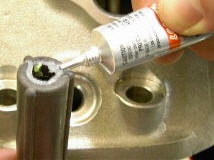
WARNING: Dielectric grease is an eye irritant. In case of eye contact, flush with water. If irritation persists, consult a doctor. Contains dimethylpolysiloxane.
Improper connections between the wire set and cap can cause damage similar to that below if not detected early. The voltage arced between the coil lead and the cap and eventually burned through the lead and rotor, destroying both. During installation, always make sure all connections are secure. The same fate happens to the ignition coil if the HT lead is not connected correctly.
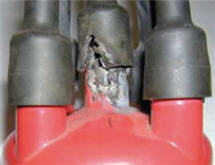
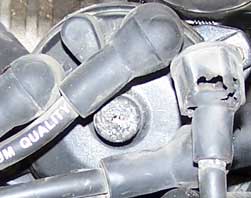
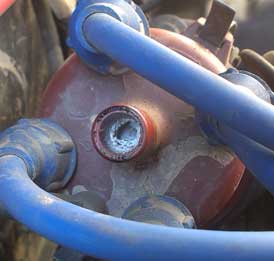
In the photos below, notice the black lines on the spark plug boot in the photo on the left. The insulation has broken down and carbon has started to build along the cracks where the insulation is destroyed. This damage was caused due to improper connection between the lead and the plug. The increased resistance caused the voltage to break down the insulation and jump to the cylinder head, as demonstrated in the photo on the right, instead of between the spark plug electrodes inside the combustion chamber. Again, always make sure of a secure connection during installation.
